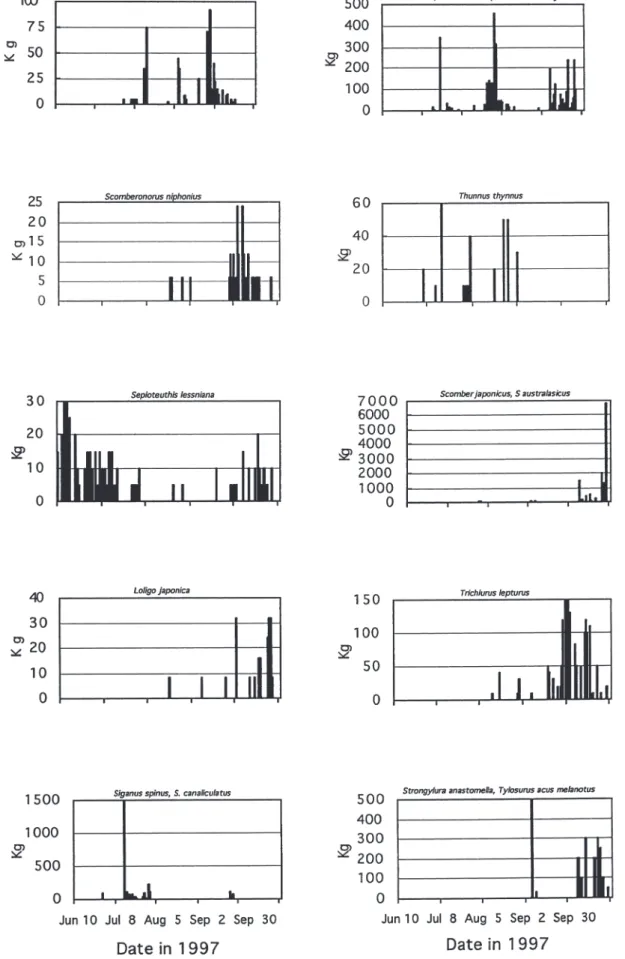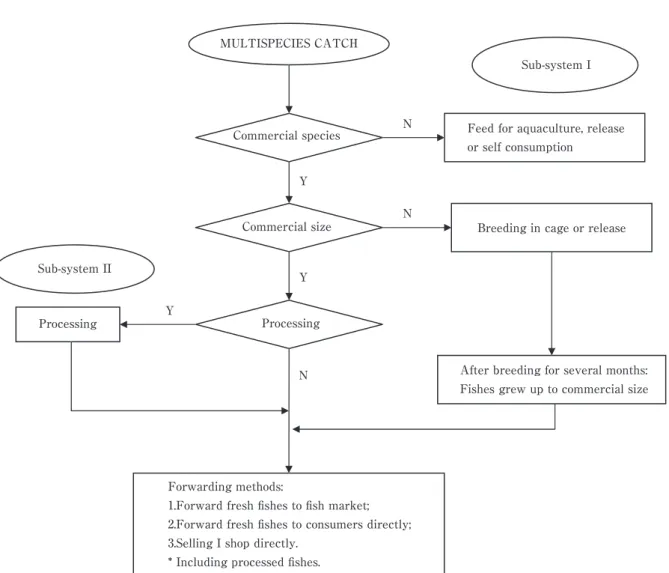A consideration of the effective multi-species utilization by set-nets in Tsushima Island, Nagasaki, Japan
Takeshi YAMANE
1Yasuhiro YAMAGUCHI
2)
)
Synopsis
One major fishery in the coastal area of Japan is the set-net industry, which uses many types of nets, each one designed for migratory species that tend to follow a shore line. The total catch of this fishery is about 678,000 t, which was almost 36% of the total coastal fishery catch (1,901,000t) in 1996. This study was conducted on a set-net operated off the Shikoe area (N34 26ʼ 40 E129 22ʼ 10 ) on the east coast of Tsushima Island, Nagasaki, Japan. The daily catch data indicated that over 20 species had been caught throughout the year. Both the catch composition and the amount of catch varied depending on the season. The methods developed in this area are appropriate in terms of reduction of discard mortality, making optimum use of harvests and reducing post-harvest losses. This report provides one example of how the optimization of this operation method for multi-species fishing has been achieved for an effective utilization of resources.
Key words set-net; discards; effective utilization.
Presently, many kinds of fishery have been operating in the coastal area of Japan. The various sizes and designs of the wide range of gear are selected reflecting the diversity of useful aquatic animals distributed in the coastal area. One major fishery in the coastal area of Japan is the set-net. Many types of nets are designed for coastal species. The total catch is about 678,000 t, which is almost 36% of the total coastal fishery catch (1,901,000 t) in 1996. It may be said in this connection that in 2004, the total set-net catch is about 580000 t, which is almost 38% of the total coastal fishery catch (1513685 t).
Commonly, the catch composition caught by this fishery is composed of many species.
The catch variations are closely related to the spatial-time distribution pattern of aquatic animals in the fishing ground. Indeed, the catch is strongly affected by environmental conditions near the fishing ground because
of the passive catching function of the gear.
And we can emphasize that, basically, this is a multi-species fishery. The effective utilization of aquatic animals caught by this fishery is in line with THE KYOTO DECLARATION AND PLAN OF ACTION ON THE SUSTAINABLE CONTRIBUTION OF FISHERIES TO FOOD SECURITY in terms of reduction of discard mortality, making optimum use of harvest, reduction of post-harvest losses, and development and use of selective, environmentally safe and cost-effective fishing gear and technique.
In actual operations with a few exceptions, it is difficult to have a large amount of commercial mono-species and avoid non-commercial species throughout the fishing period. The catch by set-net is commonly diverse in species and reflects its passive catching function. In order to utilize multi-species catch effectively, it is very important to reduce the amount of discard
and exchange information on methods and technologies to minimize waste. We discuss in this paper an example of means attempts to reduce the post-harvest losses.
Data were analyzed from daily catch of a set- net operated off the Shikoe area (Fig. 1; N34 26ʼ 40 E129 22ʼ 10 ), the east coast of Tsushima Island, Nagasaki, Japan. A set-net is set on the bottom with 33m water deep, leader is 950m long. The observation period was from June 10 October in 27 1997.
The daily catch data indicated that over 20
commercial species had been caught throughout the observation period. Daily catch variations were relatively large compared with other fisheries due to its passive catching function
(Fig. 2). Both the catch composition and the amount of catch vary depending on the season.
The results indicate that the catch is composed by many species, with non-commercially species being caught almost every day with few exceptions throughout the fishing period.
This is a quite common variation pattern in the catch caught by this fishery. It is therefore necessary to develop selective fishing methods and technology to minimize discards when considering the effective utilization for non- commercially species to reduce the post-harvest losses.
To observe more clearly the catch variations in commercial species, the daily catch caught by set-net was investigated. The species composition varied depending on the season (Fig.
3): , ,
, , ,
, , and
appeared throughout the whole period;
, were mainly caught at a
beginning of the period; ,
, ,
Shikoe
Tsushima Sea of Japan Kyushu
32°
36°
Fig. 1 Tsushima Island
10000 9000 8000 7000 6000 5000 4000 3000 2000 1000 0
100 80 60 40 20
14-Oct 0 23-Sep
2-Sep 12-Aug
22-Jul 1-Jul
10-Jun
Date in 1997
Total catch(㎏) Non-commercial and small size catch(%)
Fig. 2 Daily catch variations and the ratio of non-commercial species or small commercial species in the catch.
, the daily total catch; , the ratio of non-commercial or small commercial species in the catch.
, , ,
, ,
were mainly caught in the latter
period; ,
were caught mainly both at the beginning and at the latter period; ,
, ,
were mainly caught between the middle and the latter period.
The results indicate that the catch composition varies with time, a large species diversity appeared in the area throughout the period. Of course both the diversity and quantity in the catch are strongly influenced by the Tsushima warm current passing through Sea of Japan. We can emphasize that set-net catch is multi species and unusual to have a large amount of mono- species.
This is a specific characteristic of this fishery.
When considering the effective utilization of commercial fishery resources, this fact is very important. Indeed, one finds quite difficulty the reduction of by catch in actual operations.
On the other hand, it is necessary to provide techniques to minimize waste and discards in set-net fishery. In Fig. 4, one example proposed actually in the area is introduced using a flow- chart. In the flow, three main stages and two sub stages are provided for selection.
In the first stage, the catch is separated according to commercial or non-commercial species. Next, in the second stage, the individuals are selected depending on the size. Finally, in the third stage, they are classified as processed or fresh fishes according to the forwarding requirements.
In sub-system I, non-commercial species are used as feed mainly for aquaculture but some are released or consumed. When considering the actual conditions in operation, the selection methods in sub-system is reasonable to get seedlings for aquaculture at low cost. Of course it is necessary to provide cages for breeding under permission by authorities. This can be understood that it is one of the effective methods
to reduce the post-harvest losses.
In sub-system II for the processing, several processing methods are commonly provided to satisfy the requirements from the market. In this system, one can preserve the product after processing during several days in a warehouse equipped with freezer. According to both systems all catches caught by set-net in the area are completely used resulting in zero discard and the post-harvest losses are reduced.
The methods developed in this area is appropriate in terms of reduction of discard mortality and making optimum use of harvest, and reducing post-harvest losses.
The authors are grateful to Mr. Katsuyuki Okano of a director of Okano Fishery Ltd., Mr.
Shinpei Inoue of a student of Kinki University and to express their sincere thanks to members for their kind help to collecting the date.
Fig. 3 Daily catch variations in main commercial species.
Fig. 4 Flow-chart for effective multi-species utilization.
MULTISPECIES CATCH
Commercial species Feed for aquaculture, release or self consumption
N
Commercial size Breeding in cage or release
Processing
N Y
Y
After breeding for several months:
Fishes grew up to commercial size
Forwarding methods:
1.Forward fresh fishes to fish market;
2.Forward fresh fishes to consumers directly;
3.Selling I shop directly.
* Including processed fishes.
Sub-system II
Sub-system I
Y
N Processing
長崎県対馬における定置網少量多品種漁獲の 有効利用に関する一考察
山根 猛1・山口 恭弘 2
1近畿大学農学部水産学科漁業生産システム研究室
2長崎大学水産学部漁業生産システム学研究室
和文要旨
我が国の沿岸漁業では様々な魚種を対象に定置網が操業されている.本漁業の生産量は 678000 トン で,沿岸漁業総生産量 1901000 トンの 36%を占める(1996 年).本研究では,長崎県対馬東岸の志越漁 場における定置網を事例に現地調査を実施した.日別漁獲量・種組成は季節により大きく変動するもの の,漁期をとおして 20 種以上が漁獲された.当該域における漁獲種の利用方法は,投棄死亡そしてポス トハーベスト・ロスを減少させるように機能している.当該域において如何にして資源の合理的な利用 がなされているかについての事例を述べる.

